Ichauri-irin
Ichauri-irin is the identifier defined as, 'any sapient creature species found on Zeirenjier.' “Sapient,” meaning that they are highly intelligent and capable of self-awareness, understanding spoken and written language, and solving the problems they come across in their daily lives. The ones that built civilization, essentially. They do get their own special word to describe themselves. It's of Jeonzen origin that even creatures who only speak a variant or two of Chiruikha can recognize, as is with Etai-irin.
There are currently seven widely known species of Ichauri-irin on Zeirenjier. One could argue that blackrivers and hawkvandals could also be considered Ichauri-irin, but they are going to be described on a page that is more appropriate for them. According to the government.
I've listed the aforementioned Ichauri-irin in the order of population size within Ravenguard, from largest to smallest.
Carthraven
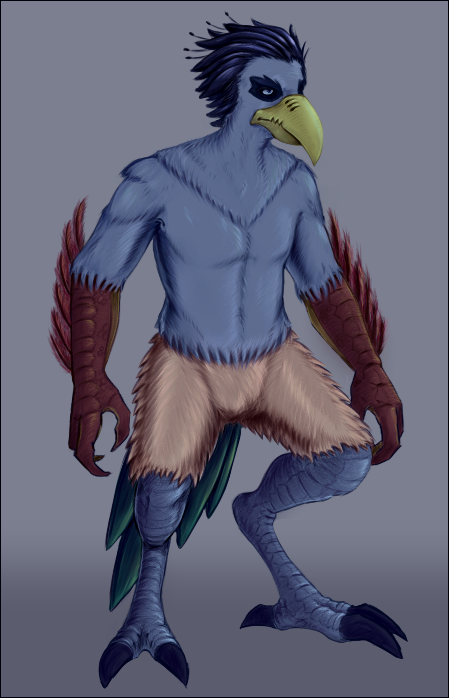
Carthravens can be described as birdlike bipedal creatures. They are the most common type of Ichauri-irin in Ravenguard, and as a result, most architecture and equipment is created by and with them in mind.
They are found in all regions of Chirua, but they are most populous in Eastern Ravenguard and least common in Talon.
Description
A common trait among carthravens is the hairlike feathers on their heads, almost always being near-black in color. Other consistent characteristics include black claws, stiff green tail feathers, yellow irises, brown upper leg feathers, blue and red scales, and short dark feathers around their eyes. The most common color for the majority of their feathers is varying shades of blue, but they can also have coats of gray, brown, and green. Typical differences between male and female carthravens are voice pitch and shoulder/pelvis widths, but are otherwise similar.
Carthraven lower jaws have decent horizontal movement in addition to vertical, and on the inside of their beaks are tooth-like structures, both of which make crops and gizzards such as in Etai-irinic bird creatures unnecessary. Their diets are similar to that of fishmongers, humans, and cerelts; being a variety of meats, plants, and whatever else they get a hold of that isn't poisonous.
In regard to reproduction, carthravens do have mating seasons, much like a lot of other species on Zeirenjier. They will usually lay one egg in the spring or summer, able to incubate it without the risk of low weather temperatures ruining everything. The resulting baby carthravens are cute grey puffballs that everyone wants to squish, of course. Actually doing it is not recommended.
Additional Details
- Despite being bird-like, carthravens cannot fly without mechanical help. Just like the rest of us.
- For most of Chirua's history, the monarch has been a carthraven, including the present-day King Rasarind Agririm III.
- Carthravens have the third-tallest average height among Ichauri-irin, measuring around five feet and eleven inches (180cm).
Human
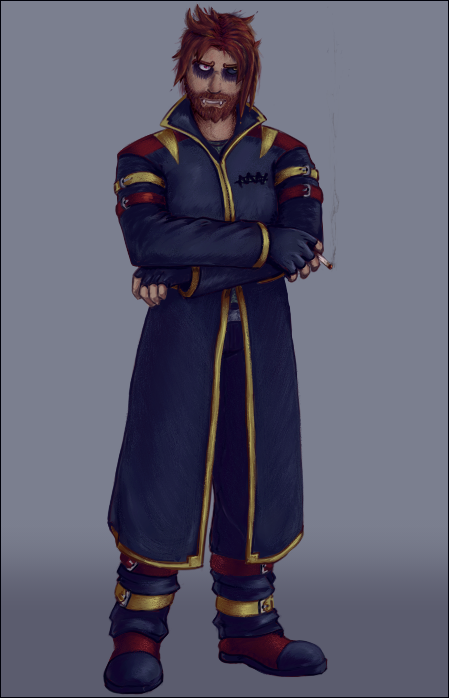
The second-most common type of Ichauri-irin are Humans, responsible for much of the progress of Zeirenjierian civilization. Humans and carthravens have seemingly worked well together over the course of history, resulting in many parts of Chirua having both species present without much conflict between them.
Similar to carthravens, humans are found nearly everywhere, but are most common in Eastern Ravenguard and least common in Talon.
Description
Humans are bipedal, mostly hairless creatures that are related to the great apes. One is maintaining this website. I've used a depiction of myself for the example as to not embarrass anyone else. You're welcome.
The most likely of the Ichauri-irin to wear clothes, as they do not have thick coats of fur or feathers to protect them from the elements. Other species generally do not need to use clothes, but have picked up the habit of doing so for style opportunities. And identification, for certain species with very similar-looking individuals.
Additional Details
- The vast majority of workers in fields that require good hand dexterity are humans, followed by fishmongers.
- Due to the discovery of hawkvandals, there has been an increase in distrust of humans from other Ichauri-irin.
- Humans may have the poorest eyesight compared to other sapient species, as many require wearing corrective lenses in daily life.
Fishmonger
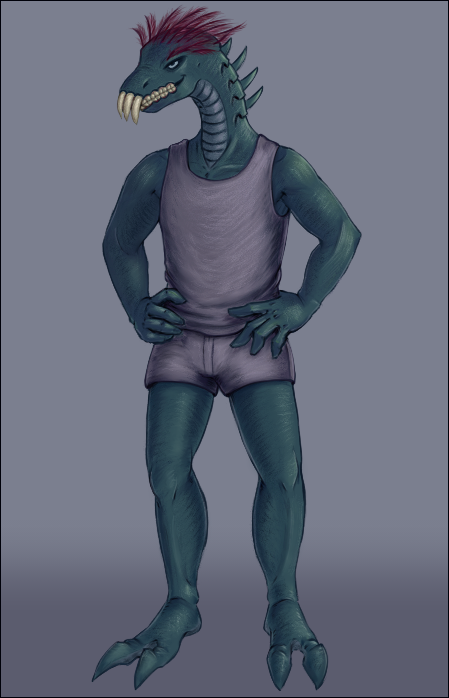
The Fishmongers are bipedal creatures similar to reptiles or amphibians. They have the ability to breathe underwater, unlike any of the other Ichauri-irin.
Fishmongers can be found everywhere except Sunfall and Talon.
Description
Patches of feathers lay on most fishmongers' heads in a wide variety of colors, like birds. They may also have horns or antler-like structures attached to their skulls. In addition to being able to breathe air, fishmongers have gills in their long necks that allow them to breathe underwater, and use that to their advantage to catch the aquatic creatures that make up the most of their diet. Another unique feature of theirs is double rows of differently shaped teeth: the outer row is somewhat like a beak for tearing, and the inner row is for grinding down food.
The fishmongers' underwater breathing allows them to take up many jobs that take place in or around water. It is one of the factors that led to their common name. A fishmonger's neck is not only long, but it also has flexible enough joints to allow them to turn their heads at angles greater than 180 degrees. As the third most common intelligent species, the structure of buildings and tools do not conflict much with their anatomy.
Additional Details
- The length of fishmongers' necks add to their height, giving them the second-tallest average of the Ichauri-irin, about six feet and two inches (188cm).
- Fishmongers resemble reptiles in many ways, but laying eggs is not one of them.
Cerelt
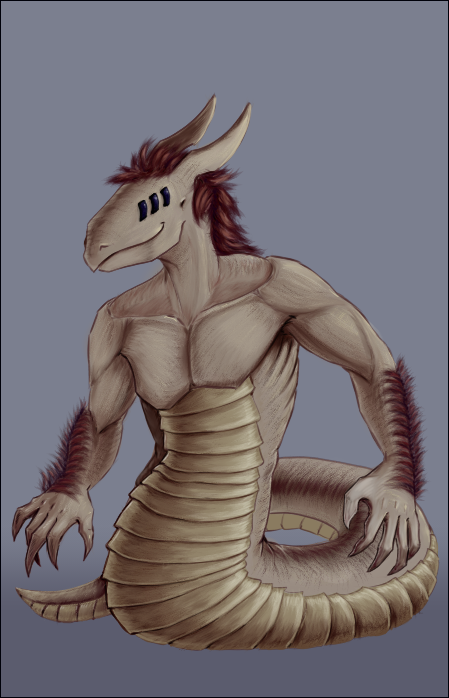
Cerelts are reptilian creatures that, like bone dragons, do not have legs. But unlike bone dragons, cerelts have real hands. And hair.
Cerelts are common in Marchwor and Talon, and can rarely be found in Distroia and Santhor.
Description
Cerelts are one of the two Ichauri-irin to have actual hair, rather than modified feathers, on their heads and arms. The scales on their palms and lower body are toughened to endure friction from moving across the ground. They appear to have three pairs of eyes, but they only have one true pair to see the world with, closest to the snout; the other two pairs are organs that help them sense the presence of spirits nearby. A cerelt will use their arms to help keep their bodies upright when not moving, and for aid in turning around. They will move at a slow speed if they do not use their hands to pull themselves forward.
While cerelts have the teeth, claws, and strength to potentially attack others with, they prefer to seek out and eat the bodies of the dead; a leftover behavior from their history of being scavengers. As expected, committing to it is frowned upon by most of society, even if they make certain that the corpses they eat are devoid of a spirit. Many cerelts will eagerly volunteer to clean up roadkill to satisfy their old behavior, but will also purchase and eat the food stocked at grocery stores like most civilized creatures.
Additional Details
- Cerelts and bone dragons are thought to have a common ancestor because of how similar they in comparison to other Ichauri-irin.
- Their ability to detect spirits gives cerelts an advantage in paranormal investigation.
Canarl
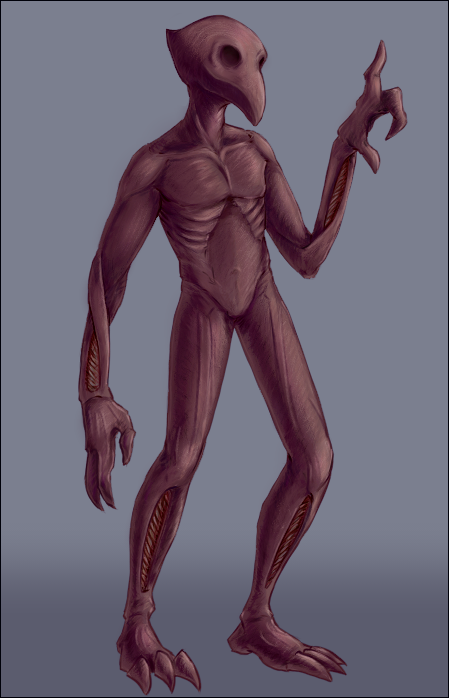
The Canarl are lanky creatures that don't seem to be from Zeirenjier, but they are! Canarl and fishmongers seem to get along well with each other more than they do with other species.
The densest populations of canarl are in Sunfall and Marchwor, and aren't common in Eastern Ravenguard.
Description
The most obvious feature of canarl is their height—they are the tallest of all Ichauri-irin, averaging at seven feet and three inches (221cm). They are rather thin with little body fat, and their bones are quite noticeable; they do not weigh much despite their height. They have little or no tissue between their forearm and lower leg bones, leaving "holes" in their limbs. Canarl scale colors range from the common reddish-brown group of colors to less common grey and blue.
Canarl do not have mouths like other creatures, but a short proboscis for feeding on liquids. They like to drink fruit juice, and will tolerate other foods that have been liquefied and strained of remaining solid matter. They will not drink blood unless they are in dire situations.
An interesting ability of canarl is their ability to detect blackrivers in hiding, and be able to physically pull them out of their hosts. The canarl themselves are immune to being controlled by blackrivers, as well. Once having killed one, a canarl will even drink its blood-like body fluid on occasion. It makes one wonder what their connection to blackrivers is, given that they are the only living being that canarl will attack and kill on sight.
Additional Details
- The canarl ability to find and kill blackrivers has inspired the masses to give them the nickname "wraithripper."
- Compared to other Ichauri-irin, canarl are a bit more primitive and run mostly on instinctual behavior. Not to say they're stupid or anything; they just like their simpler lives.
Bone Dragon
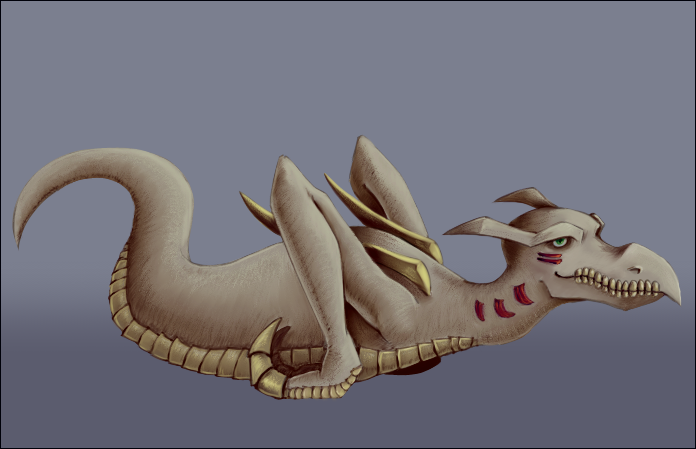
The sad story of the Bone Dragons is that they are the only Ichauri-irin that are targeted as prey in parts of Zeirenjier.
Due to this fact, the number of bone dragons is fewer than all but one species of Ichauri-irin. Rather than being common in entire regions, they are in abundance only in certain towns or cities, such as Esairin and Sangrowlinnt.
Description
Bone dragons get their name from their exposed teeth, structure of their claws, and the bony protrusions of their scapulae. Their scale color is also often compared to the yellowish grey of unbleached bones. All bone dragons have bright red, triangular markings on their necks and below their eyes. They move around by pushing the backs of their "hands" against the ground, propelling them forward. If they must move quickly, bone dragons will change the orientation of their "hands" and dig their claws into the ground. The scales on their bodies are durable enough to withstand constant friction.
As a prey animal, bone dragons have a defense mechanism to protect them from would-be predators: the ability to vomit a mixture of microorganisms from a specialized organ above their stomachs that can make most other creatures sick, sometimes fatally. Bone dragons can change the usual liquid state of their defense into an aerosol, should there be multiple attackers at once. The bone dragons themselves are immune to the potential infections, and the ever-changing composition make it difficult for other creatures to acquire immunity to it.
While there is growing distaste in the practice, bone dragons are still hunted for food in different parts of Chirua, leaving them to feel unsafe when traveling outside their specific settlements. The unique taste of bone dragon meat and the thrill of risking death from eating it draws other creatures into seeking it out. Attempting to farm bone dragons is illegal in all of Chirua, but capturing them off the streets hasn't been banned in certain places yet. Ichauri-irin rights groups have been successful in restricting the sale of bone dragon products in most of the continent, at least.
Additional Details
- If left alone, bone dragons can live to be over two hundred years old, longer than most other creatures on Zeirenjier.
- The disease-causing substance is referred to as "dragons' breath," and it's possible to request it straight from the source if asked nicely. Non-bone-dragons are not likely to use it in friendly ways, but it's not the bone dragon's problem.
Kuneik
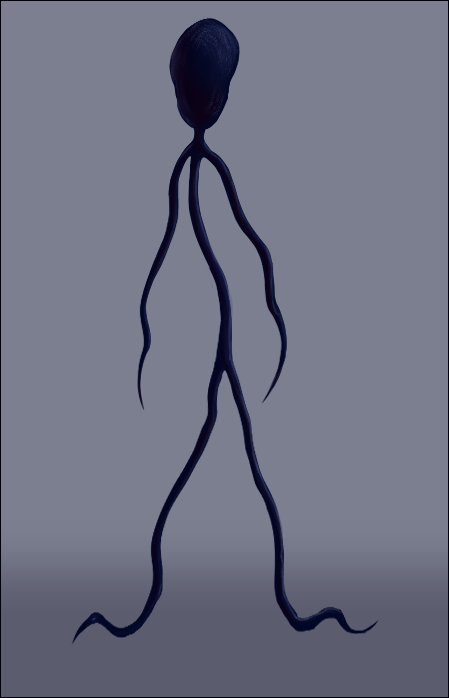
Kuneik are creatures from Iswrimark, but are categorized as Ichauri-irin just the same. Their foreign origin is clear in their appearance when compared to the other sapient species.
As the rarest of Ichauri-irin, small groups of kuneik are only found in Northern Ravenguard and Santhor.
Description
Kuneik can be best described as living, human-shaped stick figures. They are entirely black or dark blue in color, and do not have any notable features on their heads. They do not have bones, allowing them to contort their bodies in extreme ways and fit into narrow spaces that no other creature can, limited only by whether their heads fit. Despite having no eyes, ears, or mouths; kuneik can still see, hear, and speak clearly just like any other Ichauri-irin.
Similar to canarl, kuneik do not eat normal, non-liquefied foods; they must use the tips of their limbs to feed with. But unlike canarl, they can and will seek out blood to drink before other types of sustenance. They are not considered vampires, however, nor are they disliked as much. This is due to a species-wide "rule" that kuneik claim to have, being that they must ask permission to acquire the blood they want. They say that all Iswrimarkish species have their own "rules" that they must follow, and that breaking them is actually quite difficult. We would have to take them at their word, as there are no other Iswrimarkish creatures in the world to compare them to.
Additional Details
- The lack of distinct features makes it difficult to tell which direction a kuneik is facing. Coupled with their behavior of silently peeking past door frames or large objects, it's very odd.
- Many kuneik will appreciate a blender as a gift. I promise.